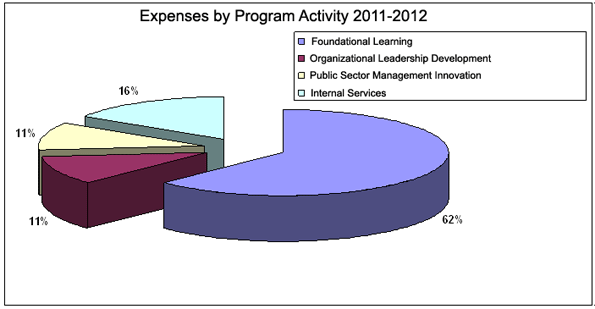Common menu bar links
Breadcrumb Trail
ARCHIVED - Canada School of Public Service - Report
 This page has been archived.
This page has been archived.
Archived Content
Information identified as archived on the Web is for reference, research or recordkeeping purposes. It has not been altered or updated after the date of archiving. Web pages that are archived on the Web are not subject to the Government of Canada Web Standards. As per the Communications Policy of the Government of Canada, you can request alternate formats on the "Contact Us" page.
Section III - Supplementary Information
Financial Highlights
Financial Statements
The financial highlights presented in this Report on Plans and Priorities are intended to serve as a general overview of the School's financial position. More information is available on the School's website at: http://www.csps-efpc.gc.ca/aut/cdo/index-eng.asp.
| Future-oriented Condensed Statement of Operations For the Year (Ended March 31) |
% Change | Future-oriented 2011-12 |
Future-oriented 2010-11 |
|---|---|---|---|
| Total Expenses | -20 | 121,291 | 150,999 |
| Total Revenues | -26 | 50,000 | 67,782 |
| Net Cost of Operations | -14 | 71,291 | 83,217 |
The decrease of the Total Expenses in 2011-12 compared to 2010-11 is attributable to
- the reduction of the School's reference levels (Strategic Review, Compensation Adjustments of 1.5 percent);
- the reduction on planned revenue; and
- the absence of carry forward amount in 2011-12.

The estimated total expenses for the Canada School of Public Service for fiscal year 2011-12 is $121,291 thousand, including $16,342 thousand for severance benefits and services received without charge.
Foundational Learning program activity will account for $76,298 thousand or 62% of the total expenses. Organizational Leadership Development expenses are forecast at $12,846 thousand or 11% of the total expenses, and it is anticipated that Public Sector Management Innovation will use $12,995 thousand or 11% of the total expenses. The remaining amount of $19,152 thousand or 16% of the total planned expenses will fall under the Internal Services program activity.
List of Tables
All electronic supplementary information tables found in the 2011-12 Report on Plans and Priorities can be found on the Treasury Board of Canada Secretariat's web site:
- Greening Government Operations (GGO)
- Upcoming Internal Audits and Evaluations over the next three fiscal years
- Sources of Respendable Revenue
- User Fees
Section IV - Other Items of Interest
1 Level 3 evaluations measure how the knowledge, skills and/or attitudes from a course are transferred into new behaviours within the workplace.
2 Collaborative Learning: The act of shared creation and discovery where learners work in groups on the same task simultaneously, thinking and learning together. Virtual collaborative tools permit users to communicate with one another (without members being physically in the same location) to share information, knowledge and best practices.
Online Learning: The act of learning through activities delivered using Internet-based technologies. It can be synchronous (learners and instructor must attend the learning event at the same time; often called virtual classroom) or asynchronous (self-paced learning independent of time).
Blended Learning: An approach to learning that combines two or more delivery methods (examples: classroom-based, computer/Internet-based, on the job training, etc.) Note: Within each of these delivery methods, the content may also have various pedagogical blends (i.e. learning strategies).
3 Internal Services includes: Management and Oversight Services; Communications Services; Legal Services; Human Resources (HR) Management Services; Financial Management Services; Information Management (IM) Services; Information Technology (IT) Services; Real Property Services; Material Services; Acquisition Services; and, Travel and Other Administrative Services.
4 The School's business model is a representation of how the organization intends to deliver its products and services in a cost-effective and sustainable manner, based on client needs. In addition to the costing/pricing framework, other main elements include the foundation (reputation and experience), the infrastructure (core capabilities, partners and business lines), the value proposition of the offered products and services, and the clients of the organization.
